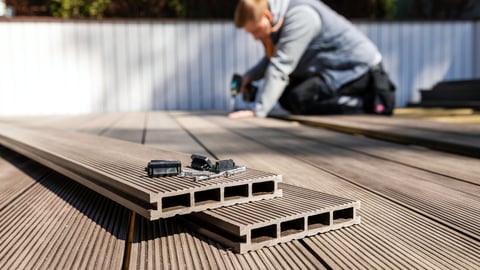The latest on wood-based composites
Wood is the backbone of building throughout much of the world. However, not all wood products and practices are created equal.
To get insights into the latest research regarding sustainable, climate-friendly wood- and wood-based products, HBSDealer.com reached out to the good folks at the Wood-Based Composites Center (WBC), which is a coordinated research partnership between major North American universities. The center “educates and trains students for careers in the wood-based composites and adhesion industries and provides intellectual exchange and interaction among professionals and students interested in the manufacture and performance of wood-based composites, wood material science and wood adhesion.”
Chip Frazier, who has worked as a professor in Virginia Tech’s Department of Sustainable Biomaterials since October 1992 and as director or co-director of the WBC since 2005, was kind enough to share some science-backed guidance on what’s shaping the climate-friendly, more efficient and effective building materials of the future.
Building better materials for generations to come
Q: Can you share some research you’re working on currently that you’re particularly excited about?
Frazier: Yes! For instance, some woods bond easily while others do not, and our members want to know why.
Currently, we are studying a resinous, high-density Australian wood, spotted gum (Corymbia citriodora). It’s a gorgeous wood, and we think it is the single most difficult wood for adhesive bonding; it’s partly due to the extractives, the natural compounds that give wood its odors, colors and flavors.
It is a simple question to ask: How do extractives affect wood adhesion? But it’s difficult to answer, and we have a large collaborative team at Virginia Tech, Oregon State and Auburn University that is taking a methodical approach. This is something that our members want but don’t wish to do themselves.
Of our current WBC projects, the spotted gum project is perhaps my favorite. But our members have great excitement over mass-timber and mass-plywood type materials, which includes primary manufacture, as well as mass-timber structures, including their durability and seismic performance.
The WBC has a broad variety of projects ranging from chemical sciences to mechanics and structural engineering. We have something for everybody; and if we don’t, just join the center, because we do what our members request!
More About Wood Adhesion
According to the U.S. Department of Agriculture: “Adhesive bonding of wood plays an increasing role in the forest products industry and is a key factor for efficiently utilizing our timber resource. The main use of adhesives is in the manufacture of building materials, including plywood, oriented strandboard, particleboard, fiberboard, structural composite lumber, doors, windows and frames, and factory-laminated wood products. Adhesives are also used in the assembly of furniture and cabinets, manufacture of engineered wood products, and construction of residential and commercial structures. Adhesives transfer and distribute loads between components, thereby increasing the strength and stiffness of wood products.”
Q: What would you say is currently the most environmentally-friendly wood-based composite available for purchase?
Frazier: Personally, I’ve purchased just about everything, except CLT, glulam and mass plywood.
My point is that all contemporary wood-based composites are environmentally friendly.
However, I believe the life-cycle assessment for OSB is very favorable for carbon storage, but that is application specific, as it should be.
<Editor’s note: Building materials that absorb or soak up carbon can help reduce greenhouse gas emissions.>
I consider them all Earth-friendly because current composite technology provides extremely efficient utilization of our timber resources. Without our current petrochemical wood adhesives, log utilization efficiency would be only about 45%, as it was in the 1940s. Today, it’s over 99% mainly due to composite technology and wood adhesives.
As for non-structural materials like MDF and particleboard, formaldehyde emissions are a regulatory concern. Nobody has yet found any viable alternatives to our current wood adhesives. But our industry has consistently met the increasingly stringent formaldehyde emissions standards since the mid-1980s. It’s a slow train, finding viable alternatives to petrochemical wood adhesives, and this is another strong interest among our members.
Q: What are some key trends you foresee in the wood-based composite industry moving forward?
Frazier: I believe building supply folks will be dealing much the same materials in the near future, but as we use more and different kinds of wood, they will be concerned about the normal things: cost and supply.
There is a great desire to reduce the density and weight of wood composites, while maintaining performance. But again, this boils down to cost.
Q: Per your research, what materials or combination of materials/adhesives tend to constitute the longest-lasting wood-based composite?
Frazier: You said as per my research, and that would be phenol-formaldehyde resin impregnated into wood using the open-cell process. That’s where the wood pores are free and open, and the resin becomes swollen all within the wood cell wall.
The same is true for polymeric isocyanate (pMDI), also impregnated in the same way. I studied that in order to understand the wood/adhesive interaction that occurs in real materials that consumers can actually afford.
Q: What message would you share with people in the building supply, hardware and lumber industries who perhaps haven’t given much thought to wood-based composites or are maybe skeptical of selling new products?
Frazier: Get on board! But I suspect they already are. Wood-based composites are superior to solid wood in many respects. They have issues, just as solid wood does. However, we live here and now.
We need to build more homes, economically and sustainably, and we need to store more carbon in more, and new, kinds of wood composite. New composite technologies are always emerging, some obviously better and others not. My observation over 30 years is that the industry is constantly improving old materials and creating new ones.




